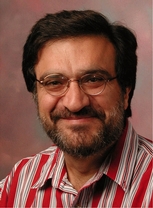Directors' Notes
From the PIMS Newsletter BIRS Special Issue, Spring 2001.
PIMS Director's NotesNassif Ghoussoub, FRSC
I will always remember how quickly Uffe Haagerup solved our problem. It was in 1986, late at night in one of the many memorable visits to Oberwolfach. My main contribution was simply to realize that a great specialist in Von Neumann Algebras was living among us. My first visit to Luminy came much later during a sabbatical leave from PIMS in the fall of 1999. By then, I had a new angle or perspective on mathematical research. Now, I was not only interested in how to practice it as a researcher, but also in how to facilitate it as an institute director. It soon became clear to me that the time had arrived for North America to develop its own Oberwolfach/Luminy center. Soon after, the PIMS executive committee enthusiastically endorsed the idea and here we are, almost 18 months later, awaiting a crucial site visit on June 15 and a historic decision by NSERC, ASRA and the NSF. The arduous journey of building PIMS wouldn't have been accomplished without the unconditional support and commitment of friends like Arvind Gupta and Ed Perkins. The road to the MITACS network couldn't have been travelled without visionary companions like Don Dawson, Luc Vinet and Steve Halperin. Here again, call it luck, I feel extraordinarily priviledged to be working on this initiative with colleagues like Robert V. Moody and David Eisenbud. With their outstanding scientific credentials, vision, dedication and integrity, the Banff station will soon be ready to be a great new resource for the world's scientific community. Many hurdles remain but whether successful or not, this effort should always be remembered as the culmination of a joint effort by a remarkable group of people who happen to be in leadership positions. Most of them are not mathematical scientists but simply great believers in the role of mathematics, its ramifications and its applications: Senior NSERC and NSF officials (Brzustowski, Lloyd, Menard, Colwell, Eisenstein, Tondeur and others) who are determined to encourage international collaborations in order to multiply the opportunities for their researchers; Senior Alberta officials (Taylor, Church, Palmer, Hill and others) who are totally committed to the R&D effort in their province; Senior administrators in the major Alberta and BC universities (Archer, Smith, Clayman, Taylor, Samarasekera, Peter, Boorman, McBride, Klawe) who were so instrumental in getting PIMS on its feet and who are now back again actively helping us build the Banff International Research Station. |
MSRI Director's NotesDavid Eisenbud 
Over many years the conference centers at Oberwolfach and Luminy have meant a great deal in my life. In 1970, when I got my PhD, I was lucky enough to have one of my first papers noticed by Friedrich Kasch, who organized a series of meetings at Oberwolfach, and who invited me to come. It was a career-defining experience. I fell in love with the setting and met quite a few of the European mathematicians who have been my friends and collaborators ever since. I've been back about once a year, and my pleasure in the place has been renewed each time. An American mathematician, Graham Evans, likes to stand at the door of Oberwolfach when a new arrival comes and say "Welcome to heaven!" My feeling about the place is the same. I know that when I go to Oberwolfach it is for a week of complete immersion in mathematics, in the company of congenial people, with long reflective walks along the hills, amidst fir trees and farms. My encounters at Oberwolfach, and more recently at Luminy, have led to the results in at least 6 of my papers - many more if you count vaguer influences. At the time I first went to Oberwolfach, most meetings there took place once a year in series that were expected to go on for ever. Typically a grand old professors and their mathematical offspring got together for a sort of wonderful mathematical picnic. Now by contrast there is intense competition for meeting times, and even established groups can find space only once in several years. As an occasional organizer of meetings at Oberwolfach and Luminy I know how hard it is to narrow the field and narrow the invitees to fit into the space available. There is plenty of excellent mathematics and a crowd of excellent mathematicians that are not accomodated. And despite the strong internationalism of these places, they naturally favor germans and french; although there is a group of North American mathematicians who go regularly, I know many fine workers in this country who have never been invited, or never had the opportunity to go. The formation of the Banff International Research Station will give many more North American mathematical scientists the opportunity to meet with peers from the US, Canada, and abroad, in a beautiful setting for intense exchange and work. All kinds of mathematics will be at home there, and I think that the Station will be a source of many new collaborations and intense partnerships, crossing national boundaries and disciplines. |






